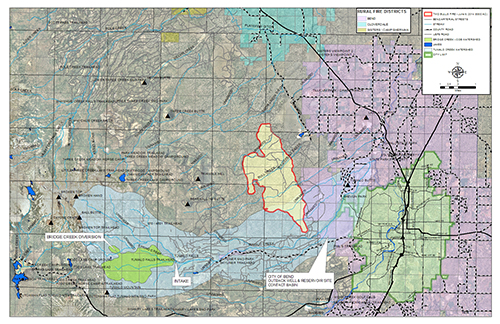
As of Monday, the Two Bulls Fire is not in the Bridge Creek watershed. The City’s Outback drinking water facilities are not in the path of the fire. The southern flank of the fire is strong right now. According to the Joint Fire Information Center progress on the fire went very well yesterday and last night, and fire managers are happy to report that the only remaining unsecured portion of the fire had line completed around it last night.
Due to the aggressive mop up operations on the eastern and southern portions of the fire yesterday, firelines were able to hold during the late afternoon winds that developed and lasted throughout the evening. Day shift crews will continue mop up operations deeper interior along the eastern flank of the fire today. On the western flank, line reinforcement and deploying hose lines will be the main focus throughout the day.
Smoke conditions should be less than it has been over the last few days, as fuels within containment lines are being consumed and mop up operations are reaching further interior. Although temperatures are forecasted to be a little lower than yesterday, the concern for today will be for increasing winds from the north-northwest this afternoon with gusts up to 20 mph.
The Bridge Creek Outback facility is where the City of Bend treats and distributes water from Bridge Creek. The City has seven wells at the Outback site and 15 wells located elsewhere across the City.
The Bridge Creek watershed is where the City gets most of its domestic water supply, fed by gravity to the City. The City shut down the surface water on Saturday night as a protective measure, and has been pumping water only from groundwater wells since.
The City shuts off its surface water when turbidity – a measurement of sediment-generated cloudiness – reaches a certain level. The turbidity measurement is currently below that threshold.
The City hopes to have the Bridge Creek surface water source back on in a few days, depending on water quality which can be affected by fire behavior and spring run-off. Groundwater wells can supply the City’s domestic water but the City is encouraging its Bend water customers to conserve water and minimize or eliminate irrigation if possible. When irrigating, it is best to do so during off-peak hours (when it is dark outside).
The City of Bend has been working with other local agencies to encourage water conservation while the City is using groundwater wells only. Deschutes County, the Bend Park and Recreation District and Bend-LaPine Schools have taken considerable efforts towards reducing irrigation.
Irrigating landscaping is not an effective measure for fire protection for those concerned about pre-evacuation warnings. Deep watering only in the event of a fire is not an effective watering practice. Plants can only soak up so much water at one time, no matter if you water once a day or once a month. By watering regularly over long periods of time, plants can retain the most water and reduce the risk of drying out and becoming combustible.
Also deep watering can create other issues, namely lack of water flow for firefighting. It can also can cause erosion problems and increase overall water usage in the community in a time of possible drought.Fire hydrants and water for sprinklers are all on the same system. If everyone is watering, then there is less water available for fire hydrants.
Follow www.centralorfireinfo.blogspot.com for regular fire updates.
Fire Season Has Arrived in Central Oregon Residents Should Prepare
Most Bend residents are experiencing the smoke throughout central Oregon from a fast-moving wildfire named the Two Bulls Fire, which swelled to 6,800 acres in the past two days. Two Bulls was spotted by a lookout on Saturday afternoon where it quickly grew in a matter of hours, prompting numerous evacuations and some residents are still on alert to leave at a moments notice.
This fire is a searing reminder that we are now in fire season and we each have a responsibility to prepare our properties for wildfire. Project Wildfire reminds residents that it’s not too late to work on your defensible space. “With the abundant growth of vegetation across the county this spring, residents are strongly encouraged to cut their grass and weeds to four inches or less to keep potential fires low to the ground where hand crews can pick them up quickly,” says Alison Green, Program Director for Project Wildfire.
Fire season is also a great reminder, that YOU are our greatest resource when it comes to protecting homes and neighborhoods. With some simple steps you are able to protect your home and community from a wildfire. Remember to keep your defensible space defined, keep grass and weeds cut low and always be prepared to respond to wildfire. With this in mind, Project Wildfire urges you to take a look around your property in the “home ignition zone” where glowing embers can ignite spot fires and vulnerable areas like decks, patios and fences that can spread flames to your home.
“That last thing you want to think about is your defensible space when a wildfire is in your backyard,” says Alison Green, program director for Project Wildfire. “Defining the defensible space around your home is the most important thing you can do to protect your home and neighborhood.”
Where are your most vulnerable places for glowing embers to ignite your home?
• Are your gutters and roof valleys free from debris like pine needles and leaves? Clean them out. Despite a metal or asphalt shingle roof, the buildup of gutter debris provides necessary fuel for the glowing embers to ignite adjacent fascia boards or siding – most often made of wood.
• Do your shrubs and weeds provide a path of fuel for fire to reach your trees or home? Reduce shrubs and other “ladder fuels” around your home to reduce the threat of ground fires igniting nearby trees, or your home.
• What can catch fire on your deck or patio or near your fence? Remove weeds, shrubs or any combustible materials from around, under or on top of your deck, patio or wood fence. This includes toys, planters, construction materials, furniture and cushions along with even small piles of pine needles or leaves.
• Is your woodpile near your home or other combustible vegetation? Move woodpiles at least 20 feet away from your home or other combustibles.
The greatest risk of homes catching fire during a wildland fire event is from the advancing ember shower that can reach your property long before an actual flame front. “The strong winds that are produced by a large fire can embers up to 3 miles away.
These embers are “firebrands” that can ignite items such as patio furniture cushions, pine needles on your roof and weeds that have grown too tall,” says Alison Green. “Firefighting resources are limited locally so it’s up to individual residents to take responsibility for the defensible space around their homes and outbuildings,” she adds.
To address this threat Project Wildfire recommends the following steps that homeowners can take right now to help protect themselves against this very real threat in central Oregon:
• Cut all grasses and weeds to 4” or less.
• Clear all pine needles, weeds, leaves and flammable debris from around your home including on roofs; in gutters; near fences; and on, around and under decks – anywhere where glowing embers can ignite and spread fire to your home.
• Reduce shrubs and other “ladder fuels” around your home that can spread fire to nearby trees or structures.
• Trim up trees to prevent the spread of fire to the upper branches, or “crowns”.
• Remove all dead, dying and diseased vegetation around your home – maintain healthy trees and shrubs.
• Move wood piles at least 20 feet from your home and away from combustible materials or vegetation.
• Keep driveways clear by trimming trees and cutting weeds for easy access of emergency equipment.
Visit www.firefree.org or www.firewise.org for more information about how you can prepare your property for wildfire season and Plan, Prep, Go guide. Or call the Project Wildfire office at 541-322-7129.




